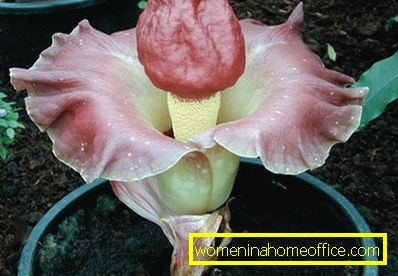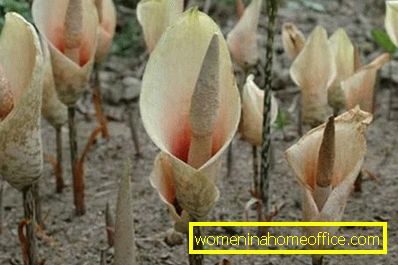Amorphophallus at home
Houseplants are not for nothing called green friends of man. Indeed, their role can hardly be overestimated: they clean and moisten the air in the room, they have a beneficial effect on the mood of the person. Each plant requires individual care, so acquiring one or another form, first of all, study its features. Today we will talk about how to grow amorphofallus at home.
What is amorphofallus?

Amorphophallus is an indoor plant belonging to the aroid family. By the way, this is a rather unusual flower. It needs a spacious room, because it grows to a very large size. The peculiarity of amorphophallus is a specific odor that is released during flowering. The smell is so sharp that often the flower has to be taken out of the room. However, it is precisely due to the smell that amorphophallus attracts insects that pollinate it.
Types of amorphophallus
In nature, there are more than a hundred different types of amorphophallus. However, only three types are suitable for growing at home:
- Amorphophallus cognac;
- Lukovitsenosny;
- Rivera.
The tuber of the first species of amorphophallus has a diameter of about 20 cm and looks like a slightly flattened ball. The color of the leaves is olive with light specks, and their petioles can reach 80 cm. It is interesting that during the flowering period the petioles heat up to 40 degrees.

Lukovitsenosny amorphofallus differs in a hemispherical tuber with a diameter of about 8 cm. It has only one leaf of dark olive shade on its stem, with light spots. Peduncle of this species has a pinkish color.

Amorphophallus Rivera, first of all, differs from its counterparts in peduncle growing to one meter. That is why at home it is grown only in greenhouses. Its sheets are dotted with a large number of brown or light specks, and the diameter of the tuber can vary from 10 to 25 cm.

Amorphophallus: home care
In order for the flower to please you with its beauty, you need to provide him with the proper conditions. Experienced florists recommend to pay attention to such features of growing amorphofallus at home:
- lighting: the plant requires a large amount of diffused light, but under the influence of direct rays of the sun it can get burned;
- air temperature: in summer, the plant needs a temperature threshold of about 20 degrees, and in winter - 10-12;
- high humidity: the plant should be sprayed frequently.
How to water amorphofallus?
Water the plant must be carefully, in no case can not pour water on the tuber, as this will lead to its rotting. When amorphophallus is in a period of active growth, it requires constant watering. But in a state of rest, which comes in the fall, it is necessary to water it much less often, completely stopping watering for the winter. By the way, excess water must be drained from the pan.
Top dressing of amorphophallus

When the plant gives new shoots, it must be fed. Fertilize the plant should be 1 every 2 weeks, alternating mineral and organic substances. Buying fertilizer, look, so that they have a high content of flora.
It is important to know: in the winter, amorphophallus sheds all the leaves - at this time it must be moved to a dark place.
How to transplant amorphophallus?
It is possible to replant a plant only in the beginning of spring when tubers let out the first sprouts. For transplanting, you must purchase a mixture designed for aroid plants. As a rule, such a mixture consists of the following components:
- humus;
- peat;
- leafy ground;
- sand.
The pot into which you plan to transplant amorphophallus should be three times the size of the plant tuber.

Procedure for transplantation of amorphophallus:
- Fill in about a third of the pot with drainage.
- Pour the soil on top (up to half the pot).
- Add sand.
- Dip the tuber in the sand and sprinkle with soil.
- Provide a moderate amount of water for the plant to bloom.
How to reproduce amorphofallus?
Propagate the plant in two ways:
- division of tubers;
- kids.
Reproduction of amorphophallus by dividing tubers:

- Take the tuber, which sprouted buds.
- Cut it gently so as not to damage the kidneys.
- Sprinkle with charcoal the place where the tuber was cut and leave to dry for 24 hours.
- Plant the tuber into the soil as described above and provide the plant with moderate watering.
Reproduction of amorphophallus children:
- When the plant goes into a dormant period, remove it from the soil.
- Tubers thoroughly clean and separate the children.
- In early spring, daughter tubers can be planted.
What diseases and pests are susceptible to amorphophallus?
In general, amorphophallus is a flower that is quite resistant to various types of diseases. However, when the plant is still young, it can affect aphids and spider mites. In order to prevent the leaves should be periodically inspected. If you find any pests, treat the plant with an insecticide. Remember that you need to process only the leaves, not touching the tuber, otherwise Amorphophallus may die.
The most common plant diseases are:
- root rot due to heavy irrigation;
- leaf drying due to low light or humidity;
- the formation of bright spots on the leaves due to insufficient lighting.
Caring for amorphophallus at home is not so difficult. If the plant is provided with timely and systematic care, then it will long delight you with its flowering. By the way, the roots of amorphophallus contain a large number of useful elements, so some plant species are eaten. However, it is not recommended to add such an extraordinary ingredient to your diet on your own: it is better to consult with experts.